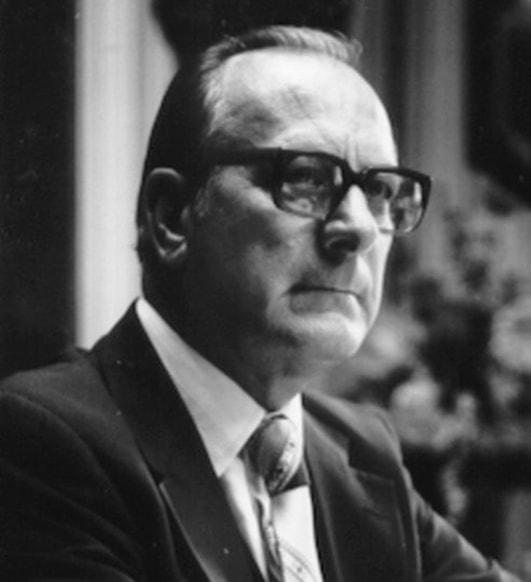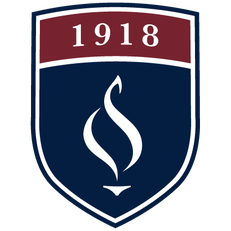Conn, Charles William

Charles William Conn (1920-2008) became president of Lee in 1970 following his tenure as general overseer for the Church of God. He served 12 years as president. A Georgia-native, the 50-year-old Conn had long been a friend and supporter of Lee. He was a student at BTS in the early 1940s, where he met his wife, Edna.
As a student, he once was attending a lecture by R.R. Walker who said, “Some of you sitting here will excel to the edifying of the church.” Young Charles Conn was gripped by that remark and soon after went to Professor Walker and told him, “With God’s help I am going to be one of those who will excel the edifying of the church.” President Conn served the Church of God as a pastor and denominational leader, including as general overseer and as a state overseer. He also served as Editor-in-Chief of publications, during which time he wrote the official history of the denomination (Like a Mighty Army), and ultimately became the official historian.
In many ways, President Conn was a self-taught man because of his love of learning. He appreciated the arts and was an effective communicator and deeply consecrated Christian. He held the trust of the church in guiding Lee’s transition into this new 4-year liberal arts college while maintaining its Christ-centered mission.
The Conn Presidency was the beginning of a new era of advancement for Lee. Academic programs expanded, he intentionally recruited faculty with strong academic credentials, and he expanded student services through resources for advising, counseling, and vocational guidance. Perhaps one of the most important things he did was make room for faculty to dream. What type of Lee did they envision? And then he went to work helping them create such a place.
Enrollment continued to increase and the 1970s were strong years for Lee. Carrol Courts was dedicated and then in 1977 the Conn Center was built (and is named for him). President Conn was intentional to raise the cultural awareness of students and engage with the local community by initiating a Community Concert Series.
Lee reached a record enrollment in 1979, but then an economic recession created challenges that led to a decrease. There was a decreasing pool of 18 year olds, federal funding was cutback, and operational costs increased. There was a failed investment that impacted many colleges and the poor economy added to the challenges. Yet, President Conn’s leadership helped keep Lee from the same consequences experienced by many other Christian colleges during those years.
In 1976 Lee was among four denominational colleges in Tennessee named in a lawsuit reviewed by the U.S. Supreme Court. Lee was mentioned as being “permeated with religion” and too religious to qualify for state assistance. The suit maintained that the spiritual life and academic life at Lee was so closely interwoven that there is no way to separate the two. President Charles Conn gave a statement to the media in which he said, “We plead guilty to this charge and have no intention of changing it. We would close the doors at Lee College before we would ever compromise our spiritual standards.” Lee and the other Christian colleges went on to win the lawsuit.
In many ways this defines the Conn Presidency– an understanding that the life of the mind and the Spirit can co-exist and in fact help inform each other and create a needed wholeness. He believed that God calls people to a variety of vocations-- some to preach, some to teach, some as scientists, some as business managers, and medical doctors and so on. He wanted the Church of God to build a college that would prepare students to be the very best. President Conn helped create what would become a new Lee, and in many ways Lee continues to benefit from his leadership initiatives.
He served as president for 12 years, the second-longest tenure of any Lee president. He was named President Emeritus, and he held this distinction until his passing in 2008. In his later years, he often could be seen doing what he did when he was president– pouring his life into students– by talking with them at the Lee dining hall, in the library, and at events. He told students his happiest days were at Lee College.
/ L.F. Morgan
As a student, he once was attending a lecture by R.R. Walker who said, “Some of you sitting here will excel to the edifying of the church.” Young Charles Conn was gripped by that remark and soon after went to Professor Walker and told him, “With God’s help I am going to be one of those who will excel the edifying of the church.” President Conn served the Church of God as a pastor and denominational leader, including as general overseer and as a state overseer. He also served as Editor-in-Chief of publications, during which time he wrote the official history of the denomination (Like a Mighty Army), and ultimately became the official historian.
In many ways, President Conn was a self-taught man because of his love of learning. He appreciated the arts and was an effective communicator and deeply consecrated Christian. He held the trust of the church in guiding Lee’s transition into this new 4-year liberal arts college while maintaining its Christ-centered mission.
The Conn Presidency was the beginning of a new era of advancement for Lee. Academic programs expanded, he intentionally recruited faculty with strong academic credentials, and he expanded student services through resources for advising, counseling, and vocational guidance. Perhaps one of the most important things he did was make room for faculty to dream. What type of Lee did they envision? And then he went to work helping them create such a place.
Enrollment continued to increase and the 1970s were strong years for Lee. Carrol Courts was dedicated and then in 1977 the Conn Center was built (and is named for him). President Conn was intentional to raise the cultural awareness of students and engage with the local community by initiating a Community Concert Series.
Lee reached a record enrollment in 1979, but then an economic recession created challenges that led to a decrease. There was a decreasing pool of 18 year olds, federal funding was cutback, and operational costs increased. There was a failed investment that impacted many colleges and the poor economy added to the challenges. Yet, President Conn’s leadership helped keep Lee from the same consequences experienced by many other Christian colleges during those years.
In 1976 Lee was among four denominational colleges in Tennessee named in a lawsuit reviewed by the U.S. Supreme Court. Lee was mentioned as being “permeated with religion” and too religious to qualify for state assistance. The suit maintained that the spiritual life and academic life at Lee was so closely interwoven that there is no way to separate the two. President Charles Conn gave a statement to the media in which he said, “We plead guilty to this charge and have no intention of changing it. We would close the doors at Lee College before we would ever compromise our spiritual standards.” Lee and the other Christian colleges went on to win the lawsuit.
In many ways this defines the Conn Presidency– an understanding that the life of the mind and the Spirit can co-exist and in fact help inform each other and create a needed wholeness. He believed that God calls people to a variety of vocations-- some to preach, some to teach, some as scientists, some as business managers, and medical doctors and so on. He wanted the Church of God to build a college that would prepare students to be the very best. President Conn helped create what would become a new Lee, and in many ways Lee continues to benefit from his leadership initiatives.
He served as president for 12 years, the second-longest tenure of any Lee president. He was named President Emeritus, and he held this distinction until his passing in 2008. In his later years, he often could be seen doing what he did when he was president– pouring his life into students– by talking with them at the Lee dining hall, in the library, and at events. He told students his happiest days were at Lee College.
/ L.F. Morgan
